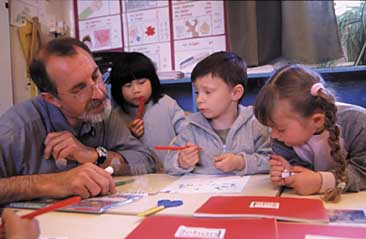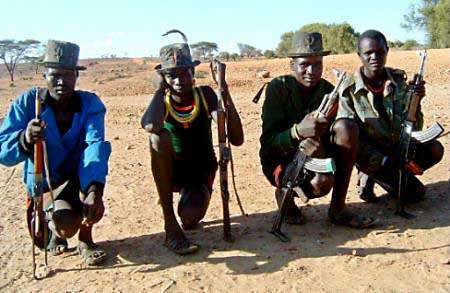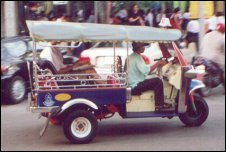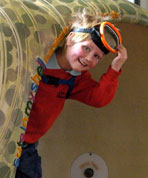NEWSBITES
FOR KIDZďż˝
MAY 1 2004
Competition through China's eyes
The time of their lives a century apart - AUSTRALIA
To Monsieur, with love - FRANCE
Positive step is medical history -AUSTRALIA
Children, old people and fashion for everyone - INDIA
Sesame Street goes to Afghanistan
Children Hold a Summit on Unity and Reconciliation -RWANDA, AFRICA
Food Entices Young Ugandan Warriors to School -UGANDA, AFRICA
Bush OKs American Indian Education Order - USA
Thai children learn more about mirrors and reflections at Bangkok
museum -THAILAND
'Enough Buddhas for today' - BANGKOK, THAILAND
News for Kidz Site Map Earlier NewsBites
Competition through
How competitive does
By Jason Leow
A British Chevening scholar, her
credentials are impressive - a master's degree in comparative social policy at
Oxford University, features editor of a top national daily at just 31 years
old, and a fluent English speaker.
Yet, there are many like her who cannot imagine leaving
the country entirely to the Invisible Hand that pats only the back of the most
talented and slaps down the losers.
Even as
It must not, said Ms Wang, reflecting on Senior Minister
Lee Kuan Yew's challenge for
He had said that
Either it modelled after the
Ms Wang said: 'I hope Chinese leaders have the wisdom to
avoid the pitfalls of the
The
The government must help, most urgently by perfecting a
social security system, because these people had few privileges, she said.
'We cannot be like
At the other end of the social spectrum are those who can
succeed. They, too, could get a leg up, if the education system, which typifies
the East Asian model with its emphasis on examinations and rote-learning, keeps
up with the times.
She looked back at the education which members of her
generation received: They not only knew little about the West but were also
almost as ignorant about Chinese culture and traditions.
In school, what passed for culture was communist ideology
and politics, she said. 'It is tragic how we have lost our Chineseness,'
she said.
She hopes today's children will learn more about the West
and be just as knowledgeable about their own history and traditions.
This kind of education would give them a global mindset,
which should include being able to speak English, she said.
'There is no need to resist English blindly because you
think it is too dominant. You cannot deny that it is an international
language,' she noted.
http://straitstimes.asia1.com.sg/asia/story/0,4386,248686,00.html
The time of their lives a century apart -
Leah Moore
April 30, 2004
MORE than 100 years of experience separate Louise Russell
and Clayton Kimeklis, but five-year-old Clayton is
pretty sure not much has changed since Mrs Russell
was a child growing up in the 1900s.

YOUNG at heart ... Clayton Kimeklis,
5, gets a hug from 106-year-old Louise Russell after the concert yesterday.
Picture: David Kelly.
"She would have played with PlayStations, I've got a
PlayStation but it's broken, cars, I've got heaps and
heaps of cars and Barbie," he said yesterday.
Clayton was one of 12 children from the Nurseryland Childcare Centre who yesterday entertained 10
members of one of
Nurseryland Childcare Centre managing
director Adam Baker had tried to explain the audience's age ďż˝ which
collectively totalled 1034 years ďż˝ to his young
charges, but understandably the four and five-year-olds struggled with the
concept.
"One said: 'Will there be one that is a thousand?'
One said: 'Will they die?' And another one said: 'We'll have to get a photo so
they remember us'," Mr Baker said.
He said the performance was designed to bring members of
the 100+ Club, which started nine years ago and now has about 300 members in
The children, who had practised
twice a day for four weeks, yesterday performed favourites
including Advance Australia Fair and Home Among the Gum
Trees to an appreciative audience who didn't seem to notice the children were
more yelling than singing.
"I really think it went very fast and I enjoyed every
minute of it," Mrs Russell said. "The
children were well trained, they did a wonderful job."
The centenarian was born in
"I had a really exciting childhood because I left
school when I was 11 and went and minded children all over the place . . . I
earned four shillings a week . . . It trained me for life really," Mrs Russell said.
Her husband died 45 years ago and she said her independent
spirit was what had kept her going all these years.
Although young Clayton found it possible to imagine a day
when he himself would be old, he certainly wasn't looking forward to it.
"I don't want to be an adult. I would hate being 100 because then I would
be very old," he said.
The Courier-Mail
http://news.com.au/common/story_page/0,4057,9427265%255E3102,00.html
To Monsieur, with love -
April 30, 2004
Nicolas Philibert's humble
school documentary was a surprise hit in
TO BE AND TO HAVE
Director: Nicolas Philibert
Three ingredients you might expect to see in a box-office
hit: a sexy leading lady, a car chase and head-shattering explosions. If we're
talking about a box-office hit in
By contrast, here are three ingredients you'll find in a
French film called To Be and to Have (Etre et Avoir): children
finger-painting, children doing maths and children
loitering in a playground. You won't find Emmanuelle Beart,
big bangs or any member of the Depardieu clan.

DNA evidence - and a quick hand check - proves that Jojo did steal the chocolate cookies.
To Be and to Have flopped, then?
Not at all. Improbably, this modest doco was a record-breaking hit in
The first hint that writer-director Nicolas Philibert had done something right was when his film was
chosen to screen at
"That was the most exciting," says Philibert. "We were there all together, with the
children and their parents. It was very moving. It's not often that a
documentary is included in the Official Selection at
"But the most exciting thing was not the screening
and the red carpet. Especially for the youngest, the most exciting [thing] was
going to a merry-go-round on the beach afterwards. Half of the kids had never
seen the sea before."
To Be and to Have is, on the face
of it, the story of a single-class school in mountainous central
It sounds like an insignificant topic, but turns out to be
the opposite.
As you get to know these kids, their daily trials become
much more compelling than, say, Tom Cruise's latest attempt to defuse a pretend
bomb.
"I think we can make good films from small
subjects," says Philibert. "It's more a
question of the way of telling and a way of looking."
Philibert spent five months searching for
the perfect location. There are between 7000 and 8000 single-classroom schools
in
"The school is not in the high mountains, not like in
the Pyrenees or the
"One of the reasons why I chose this school is, of
course, the personality of the teacher.
I think his personality is quite complex. He's both open
and secret; he's patient and also serious. I thought he might be a strong character
for a film."
The teacher, Georges Lopez, makes an excellent leading
man. He's one of the main reasons To Be and to Have is
such a wonderful film. Lopez embodies its best qualities: both man and film
impart the value of patience and the beauty of the everyday.
Not that Philibert knew this
about Lopez when he set out.
"I don't start the film from the idea of delivering a
great message," he says.
(Intriguingly, it was reported last year that Lopez was
suing the filmmakers for 250,000 euros ($404,000) compensation. The retired
teacher argued the filmmakers had exploited his image without authorisation.)
Philibert was born in 1951, and started
making films for TV in the late '70s before moving into feature filmmaking. In
1990's
These unassuming docos have won Philibert major prizes at the Cesars
(French Oscars), but To Be and to Have is his most
feted film. Last year,
"When I'm shooting, I don't know what I'm going to
shoot," says Philibert.
"Usually I say, 'The less I know, the better I feel.'
When I prepare a new film, I don't read about the subject. I love this way of
making the film, of having to invent the film day after day. So it's a question
of relationships with people. I think my films are more films 'with' than films
'about'."
That's true of To Be and to Have: it's the sense of
growing close to Monsieur Lopez and his pupils that gives the film its power.
Also, we're watching an old-fashioned type of schooling that is slowly
disappearing.
"When the film was released, many people said they
didn't know this type of school still existed," says Philibert.
"It talks about something more universal: about what it is to grow up.
"The film may touch people because it talks about how
hard it is to be self-confident when you're growing up ... about finding a way
to your own personality."
http://www.smh.com.au/articles/2004/04/29/1083103606289.html
Positive step is medical history -
By ZOE TAYLOR Medical Reporter
The Daily Telegraph
April 29, 2004
SAMUEL Nakkan has already made
medical history twice in his young life.
After being diagnosed with bone cancer in his right leg,
The seven-year-old is the first patient in the southern
hemisphere fitted with the revolutionary expandable prosthesis.

His parents feared his leg might be amputated but in
August specialists at Sydney Children's Hospital,
Samuel has delighted his family and doctors with his
progress since a second course of chemotherapy ended at Christmas ďż˝ he is
learning to walk with the help of a stick and even swimming.
His hair has grown back, he's put on weight and his left
leg grew about 1cm longer than his right.
Then orthopaedic surgeon Dr Ian Woodgate last week performed a painless procedure to expand
the fake bone.
Heat from an electromagnetic field was used to release a
spring within the prosthesis for a few seconds to let it lengthen 1.75cm.
Samuel walked out of hospital that day. He told yesterday
how the procedure felt like someone was "squeezing" his leg.
It will be repeated every three or four months until he's
16 or 17.
Samuel's mother Beth, 39, said: "Our greatest fear
was that he'd lose his leg altogether, so this technology has been absolutely brilliant
in saving his leg and getting him functioning. Every day we're really thankful
to God for bringing him through this.
"But it wouldn't have been [possible] without the
company who made the prosthesis, the oncology team for killing the cancer and
Dr Woodgate for doing the surgery and the physio."
Samuel's father Sam, 40, said: "We feel the worst is
probably behind us ďż˝ and that's great."
Samuel sometimes needs a wheelchair or a walking stick.
"It's OK ďż˝ sometimes it hurts," he said.
"[But] I can walk around. I can swim."
The hospital's cancer service director, Professor Glenn
Marshall, said: "He's an amazing guy. He's done better than I
expected."
Surgery to fit the second expandable prosthesis to another
young patient took place at Sydney Children's Hospital last week.
�www.dailytelegraph.com.au
Children, old people and fashion for everyone -
If you think fashion is not for real people, come see
Wendell Rodricks.
The designer from Goa broke
every cliche in his show on Thursday at the fifth
Indian fashion week being held in
Rodricks, who fits every notion of the
laid back Goan, placed whistles on every chair on the
audience and when a five-and-a-half year girl stomped up the runway throwing
clumsy air-kisses, everyone in the audience blew those plastic birthday party
whistles.
If joy can flood the runway and seep into dazed audiences,
slightly zonked on the third day of a bustling fashion week, pushing out the
snoot and seriousness of high fashion, it happened at this show.
Laughing old men, with white beards and flowing moustaches,
holding the hands of laughing women walked up the runway blowing pipes.
Awkward teenagers flung open their jackets showing off
'normal' bodies.
"My show is about fashion democracy," said Rodricks. "All sizes, all shapes,
all pockets and for everyone."
The line begins at around Rs.900 for jersey separates and
goes up to Rs.5,500 for silk tunic sets.
"I want to throw open the world of fashion, come one,
come all," added Rodricks, who roped in
celebrity veejay Malaika Arora Khan for a one time strut on his show.
After the show, scribes asked the men and women, and
children -- all friends of the designer -- if they were nervous. As an answer,
the child who opened the show blew a few more kisses.
And one old man added: "But believe me, he didn't
have to ask us twice to do the show."
http://news.newkerala.com/india-news/index.php?action=fullnews&showcomments=1&id=14295
Sesame Street goes to
From correspondents in
30apr04
ELMO, Cookie Monster and the rest of the
About 400 kits will soon be distributed in
Children will see a dubbed version of the
The kits have been provided by the Sesame Workshop, the
show's non-profit educational arm, and the RAND Corp., a non-profit think-tank
based in
"Because of the Taliban's repressive regime, a large majority
of Afghan children have little or no educational background," said Cheryl Benard, who heads
"This material has been assembled specifically to
address the needs of a post-conflict society."
RAND and the Sesame Workshop got help from
"We are very pleased with this gift," said Sekander Giyam, adviser to the
Afghan minister of education. "We need our children to have their eyes and
their minds opened to new ideas," he said.
The videos will be also shown in women's centers,
orphanages, children's centres
and in specially equipped travelling vans.
Episodes will be broadcast on national and provincial
television, but few Afghan families have television sets.
The episodes help teachers with instruction, foster
awareness of other cultures, highlight opportunities for women and increase
student interest in education and careers.
It is funded, in part, by
ďż˝ ďż˝ Herald and
Weekly Timesďż˝
http://www.heraldsun.news.com.au/common/story_page/0,5478,9430332%255E1702,00.html
ďż˝
Children Hold a
United Nations Children's Fund (
April 29, 2004
The national Unity and Reconciliation Commission in
collaboration with UNICEF, Ministry of Education and all other partners are organising a summit in which the children will discuss
their experiences, views and perspectives on unity and reconciliation ten years
after the brutal genocide in
Prior to the summit, children carried out community
dialogue with parents, teachers, local, district and provincial authorities.
These meeting were led by children aged 10-16 years and generated a
considerable amount of attention and identified key issues of concern to the
children regarding three themes: unity, reconciliation, peace, the right to
education for all and the future Rwanda they would like to live in.
The summit, to be held in Intercontinental Hotel, is aimed
at providing an opportunity for children to actively participate in expressing
their experiences, making future proposals and creating a platform to raise
issues related to child rights and making
"This is a real study tour I am making. I learn
things I never heard of the adults' dialogues on Unity and Reconciliation"
exclaimed the Executive Secretary of the National Unity and Reconciliation
Commission (NURC), Miss Fatuma NDANGIZA.
Two children (one male and one female) were democratically
elected to represent their districts at national level. All the child
representatives were assembled in Gitarama,
approximately 30 miles from the capital
ďż˝ Children speak out their minds freely and are likely to
reflect the real world. They also look positively to the world around them and
so can provide positive solutions to issues of concern to them ďż˝ said the
UNICEF Rwanda Representative, Mrs. Bintou Keita.
"Based on what I saw and heard and all the
consequences of genocide on my life, I wish it never happen again. I also wish
any ethnic based conflicts are eradicated and we all are called Banyarwanda", said a child delegate, Nturanyenabo E.
The children will present their views in the presence of
the Prime Minister of the Republic of Rwanda, Ministers, Members of
international community, religious leaders, national and local leaders as well
as civil society in a child-friendly atmosphere created by the children
themselves. Subsequently the children will pay a visit to the parliament and
the senate to discuss their concerns with the legislators in the country.
http://allafrica.com/stories/200404290602.html
Food Entices Young Ugandan Warriors to School -
New Vision
By Tim Cocks
April 26, 2004
MOROTO,
IT'S official: the Karamojong are finally making the transition from warriors
to school boys. A school feeding programme that
encourages parents to school their children by relieving the burden of hungry
mouths is finally paying off, district officials claim.
The brightest boys in
"A child with brains means he will be good at looking
after cattle and searching for food, so we didn't like to have him in
school," said 29-year-old Grace Oyoyo, who had
given little thought to her son Moses's education.
"But now he can go in the morning and be finished
early," she said.
Moses has benefited from a program, launched in 1999, that
lures thousands of Karamojong children away from a
life of cattle rustling and shoot-outs by giving them food if they turn up for
lessons.
As well as filling stomachs in a drought-prone corner of
the East African country, the scheme gives youngsters the time to tend their
cows after class, fulfilling a tradition sacred to a tribe renowned as fearsome
warriors.
More than 21,000 pupils are now enrolled in the
government-run Alternative Basic Education for Karamoja,
or ABEK, and officials say last year's local literacy rate of six percent has
since doubled.
"Before ABEK really gained momentum, it was very rare
to see a Karamojong kid in school," said Luke Lokuda, Moroto district's chief
administration officer.
"Now you find parents volunteering to bring their
kids to pre-primary. That was unthinkable only a few years ago."
At the Amiji-miji center in Moroto, 7-year-old Mary Lochiam
is one of 86 children enrolled in the program.
"School is good because there is enough food and we
can talk to the other children," she said as a group of children sitting
around her on the floor under a thatched shelter sang songs about numbers and
vowels.
STRUGGLE TO SURVIVE
Life for the semi-nomadic Karamojong
in the mountainous region bordering
Cousins of the Kenyan Masai, the
Karamojong have for centuries wandered the western
fork of the
Only one percent have ever used a
telephone, according to Ugandan government statistics.
The Karamojong remain a warrior
tribe, best known to the outside world for their cattle raiding expeditions
against neighboring ethnic groups and clans.
ďż˝

Four young warriors of
"Before ABEK really gained momentum, it was very rare
to see a Karamojong kid in school," says Luke Lokuda, chief administration officer for Moroto district, "now you find parents volunteering to
bring their kids to pre-primary. That was unthinkable only a few years
ago."
The ABEK programme was launched
in 1999 but its real impact was only felt last year. There are now 21,200
enrolled.
The school feeding comes at a time when Karamoja is still suffering from one of the worst droughts
in living memory. Food is scarce and many Karamojong
have resorted to foraging for food.
"The food is really the greatest enticement for
children to go to school," says minister of state for disaster
preparedness Christian Aporu on a trip to Moroto last week, "food rations from the WFP [World
Food programme] have relieved the burden of feeding
children in a way that makes education an immediate necessity for them."
Here at the Amiji-miji centre in
Moroto, 86 children are enrolled under ABEK. In a
basic thatched shelter, pre-school kids with pierced ears and kaleidoscopic
necklaces sit on the ground clapping and singing songs about vowels and
numbers.
"It is not just a question of food," said Aporu, "This programme has
enabled the Karamojong to value education. The more
they see other Karamojong being educated and filling
posts like teacher, administrator or LC5 chairman, the more education makes
sense as something that can advance you not something forced on you."
Policymakers hope to use education to integrate Karamoja with the rest of
The bad habit of cattle rustling remains the number one
obstacle. Heavily armed Karamojong raiders are still
attacking villages on pillaging expeditions, stealing cows and killing scores
of people in the process.
"If we want development, we can't have children
trained to be warriors," Namirembe Bitamazire, Minister of State for Primary Education, said
on a visit to the region. "The aim of ABEK is to see children becoming
doctors, teachers, politicians." The syllabus is
also adapted to the Karamojong way of life. "The
Karamojong are semi-nomadic," explains Henry Nickson Ogwal, the coordinator of
the Commonwealth Educational Fund (CEF), "so children look after cows. So
we start the child's education with a cow. How many legs does it have? How many
if you add the number of its front to its back legs? In this way, they learn
arithmetic."
Before last year, Grace Oyoyo,
29, hadn't given much thought to putting her child,
Moses, in school. "A child with brains means he will be good at looking
after cattle and searching for food," she said, "so we didn't like to
have him in school. But now he can go in the morning and be finished early. It
is good because to have my child educated is very important." The programme still has challenges,
for one thing, even when children make it through primary school under the ABEK
programme, there is a high dropout rate, as few Karamojong can afford to continue to secondary school.
http://allafrica.com/stories/200404270004.html
http://www.reuters.co.uk/newsArticle.jhtml?type=featuresNews&storyID=4752270§ion=news
Bush OKs American Indian Education Order -
April 30, 2004
WASHINGTON (AP) - Tribal leaders were at the White House
on Friday to watch President Bush sign an executive order aimed at improving
the education of all American Indian and
The executive order creates a federal working group,
co-chaired by Interior Secretary Gale Norton and Education Secretary Rod Paige,
which is charged with helping American Indian and Alaska Native children meet
the standards set by the No Child Left Behind Act.
Bush quoted the late Sam Ahkeah,
former chairman of the Navajo Nation Council, who once said: ``We must encourage our young people to go into education. We
need thousands of young lawyers and doctors and dentists and accountants and
nurses and secretaries.''
``Our kids have got to learn to read,'' Bush said. ``We
want to improve preparation for college and the work force. We want there to be
high high school graduation rates.
``In other words, we're going to raise the standards.
That's what this commission is going to do. It's going to work with the
(tribal) leadership to say, `How can we work together to raise the standards
and expect the best?'''
Under the order, Norton and Paige will organize a national
conference to discuss ways to meet these goals, while maintaining a tradition
of cultural learning, he said.
http://www.guardian.co.uk/uslatest/story/0,1282,-4039922,00.html
Thai children learn more about mirrors and reflections at
By Channel NewsAsia's
ďż˝
It is all happening at the Children's
Learning about the concept of reflections and illusions in
a science class can be boring.
So to bring theory to life, the Children's

This boy's body may seem to have disappeared, but it's all
a mirror trick
In one example, a 'ghost' seems to disappear in front of
the children's very eyes.
These types of images, used in old fashioned horror
movies, are simply through the clever use of a mirror reflection.
Upon closer inspection, you will see that the ghost did
not disappear, but merely moved to the other side of a mirror.
"We want kids to have fun while they're learning. We
hope that in the process of having fun, they'll start to question the situation
and find answers," said Tanasiri Suteetorn, Head of Special Projects.
And that seems to be exactly what the children are doing.
A floating head display is by far the most popular
exhibit.
A quick glance may suggest that a human head is sitting in
a fruit basket, but after a closer look, you will find that the table is not
really a table at all.
It is a box lined with mirrors on the outside.
Kids simply crawl into the box and poke their heads out of
a top hole to appear as though their body-less heads are sitting in a fruit
basket.
Those are not the only things on display at the
"Illusions" Exhibition.
Children aged 6 to 11 can enjoy a house of mirrors,
3-dimension images, and also know what it is like to see through the eyes of a
bug. - CNA
�http://www.channelnewsasia.com/stories/southeastasia/view/82525/1/.html
ďż˝'Enough Buddhas for today' -
By Leigh Turner
Published: April 30 2004
ďż˝
At the Thonburi Snake Farm,
dusty display cases stand derelict. Half the exhibits ("banded krait,
poisonous") seem to have escaped. Beneath a canopy, a small audience,
dulled by heat, watches a bare-footed handler torment two cobras until they
strike at him; then he grabs one by the head, forces its fangs through a
plastic membrane, and milky venom pours into a jar.
Next on is a copperhead racer: a big, fast-moving,
brown-and-black-striped snake. The handler goads it until it leaps over the low
barrier that separates the snakepit from the
audience. Children scream and scatter. "I forgot to tell you," the comp�re says; "this one is not poisonous."
Six time zones ahead of western
Europe and six behind
Every parent knows that when it comes to sightseeing with
children, less is more. We should have known the fabulous sculptures of the

Top temple was Wat Pho, with its shady gardens, fountains and 46-metre long
gold-plated Reclining Buddha: "It's massive!"
A canal tour also started well: the wizened driver on his
raised seat, and the long-tail boat with its massive on-board motor, were
reminiscent of Star Wars. The children gazed with interest as we passed
dwelling-houses on stilts over the murky water, laundries festooned with
fluttering shirts, and a Chinese coffin shop, the white cases decorated with
more gold Buddhas. When we stopped
to feed catfish, a seething shoal of white and grey rose to the surface like a
single organism to consume our 20-baht loaves.
But then things went downhill. The "Sai Thong Floating Market" was neither floating, nor a
market, but a large shed housing a hoard of tourist tat. "Truth is, no
more floating market in
By the time we stepped off the boat we all wanted to
return to the hotel. If the children had had their way, we'd have spent our
whole time there. The Metropolitan is an oasis of calm on the
Said Anna at breakfast: "I just looked at the bread,
and the waiter said 'Do you want some toast?' I feel like a queen." But
best of all was the pool: outdoors, beautiful to look at, and big enough to
swim in and to lounge by.
What they least enjoyed was getting around. Transport in

Eating and street markets scored highly, too. At the Suan Lum night market we entered
an ancient temple. "It's made of polystyrene," Owen said. He was
right. The painted blocks masked a 24-hour tourist police station. In the
warren of brightly lit stalls selling everything from DVDs to chameleons, a
little pocket money went a long way. But on the walk home, with traffic roaring
by, both children pulled up their shirts as impromptu face-masks.
Good food is everywhere in
Our final day found us lounging by the pool. "How
would you describe
Anna: "Smiley. Smelly."
Owen: "Polluted. Tasty."
There were several hours left before our flight to
It was no contest.
"Actually," Anna said, "I've just about had
enough Buddhas for today."
http://news.ft.com/servlet/ContentServer?pagename=FT.com/StoryFT/FullStory&c=StoryFT&cid=1083180176197
����
ďż˝
ďż˝
A MAGICAL world under the sea has been brought to life for
two youngsters at a new exhibition opening today.
Brody Mace-Hopkins and Eilidh
MacDonald, both 5, of Glendale Primary, Pollokshields,
were given a sneak preview of the new 'On the Beach, Under the Sea' exhibition
at Scotland Street School Museum.
They even got to sit inside a giant shell and swap jokes
with a hermit crab.

The free exhibition, which runs until August 23, also
includes a beach hut for storytelling, camouflage tunnel, shell investigation
station and a video shown from inside a treasure chest. A MAGICAL world under
the sea has been brought to life for two youngsters at a new exhibition opening
today.
Brody Mace-Hopkins and Eilidh
MacDonald, both 5, of Glendale Primary, Pollokshields,
were given a sneak preview of the new 'On the Beach, Under the Sea' exhibition
at Scotland Street School Museum.
They even got to sit inside a giant shell and swap jokes
with a hermit crab.
The free exhibition, which runs until August 23, also
includes a beach hut for storytelling, camouflage tunnel, shell investigation
station and a video shown from inside a treasure chest.
http://www.eveningtimes.co.uk/hi/news/5026073.html

�� Australian
Charles Billich (L), a famous painter for his
Olympics-related paintings, and Chinese He Zhenliang,
member of the International Olympic Committee, attend the "Begin
Painting" ceremony in
Pupils in egg battle -
POLICE were called to a school bus in
One parent hit out after he said his daughter was
targeted. He said: "My daughter was covered from head to foot with
yolk."
http://news.scotsman.com/education.cfm?id=496172004